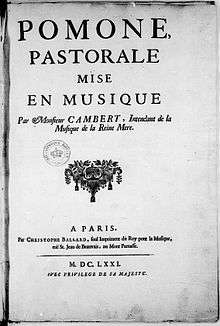Pomone (opera)


Pomone (Pomona) is a pastoral opera in a prologue and five acts by Robert Cambert with a libretto by Pierre Perrin. It has been described as "effectively the first French opera."[1] It was first performed in Paris at the Jeu de Paume de la Bouteille theatre belonging to Cambert and Perrin's Académie d'Opéra on 3 March 1671. The production had ballets choreographed by Des Brosses[2] and sets and machinery designed by Alexandre de Rieux, marquis de Sourdéac.[3] The novelty of the work drew large audiences and the opera enjoyed 146 performances over the eight months of its run.[4] The score of Pomone has only partially survived.[1]
Background and performance history
Attempts had been made to introduce Italian opera to France in the mid-17th century but French audiences had disliked the genre, preferring their own form of stage music drama, the ballet de cour, a ballet containing sung elements. Nevertheless, some French composers began to experiment with developing opera which would better suit national tastes. On 28 June 1669, King Louis XIV had granted Perrin and his Académie d'Opéra the monopoly on performing operas on the Parisian stage. Pomone was the first production by the Académie.[5] It contained many of the features audience were used to in the ballet de cour: dance, spectacular stage effects and rich costumes. The innovations were the replacement of spoken dialogue by recitative and the use of more complicated vocal ensembles. The pastoral theme of the work was not new, for instance Cambert had already composed music for a stage work called the Pastorale d'Issy in 1659.[6] In spite of Pomone's success, Perrin soon ran into financial difficulties. The Académie staged another opera with music by Cambert, Les peines et les plaisirs de l'Amour, in early 1672, but the king then revoked Perrin's monopoly on opera production and transferred it to his favourite composer, Jean-Baptiste Lully, who would have more success in establishing a lasting French operatic tradition.[7] Cambert moved to London with his pupil Louis Grabu, where he staged a version of Pomone with additional music by Grabu.[1]
Roles
| Role | Voice type | Premiere cast, 3 March 1671[8] |
|---|---|---|
| Pomone (Pomona), goddess of fruits | soprano | Marie-Madeleine Jossier, called "Cartilly" |
| Flore (Flora), goddess of flowers, Pomone's sister | soprano | |
| Vertumne (Vertumnus), god of Lares, in love with Pomone | basse-taille (baritone) | François Beaumavielle |
| Faune (Faunus), god of villagers, in love with Pomone | basse-taille | Pierre Rossignol |
| Dieu des Jardins (God of gardens), in love with Pomone | ||
| Juturne, a nymph of Pomone | ||
| Venilie, a nymph of Pomone | ||
| Beroé, Pomone's nurse | ||
Synopsis
Vertumne is in love with Pomone and Pomone's nurse Beroé is in love with Vertumne. Vertumne assumes various disguises in his attempts to seduce Pomone: a dragon, Pluto, Bacchus. He only succeeds when he disguises himself as Beroé, because Pomone cannot refuse her old nurse a kiss.[3]
Recording
The surviving 30 minutes of music was recorded by Hugo Reyne, conducting La Simphonie de Marais, on a 2-disc CD set also containing Jean-Baptiste Lully's Les fêtes de l'Amour et de Bacchus (Accord, 2004)
References
Notes
- 1 2 3 Sadler 2001, p.180. Bashford 1992, p. 697: "Considered by modern scholars to be the first true French opera..."
- ↑ Powell 1995, p. 179; Guest 2006, p. 7. The dances for Pomone have generally been attributed to Pierre Beauchamps, based on the 'Receuil de Tralage' (ca. 1697; MS 6544, Bibliothèque de l'Arsenal, Paris), but an unnumbered manuscript in the archives of the Comédie-Française, discovered by John S. Powell, states that Beauchamps did not join the production until two months before the end of the run, and that Des Brosses had created all the dances before he relinquished his position. Apparently Des Brosses left Perrin's Académie in order to work on Jean Donneau de Visé's musical machine-play Le Mariage de Bacchus et d'Ariane, performed at the Théâtre du Marais in the winter of 1671–1672.
- 1 2 Jean-Claude Brenac.
- ↑ Johnson 2008, pp. 100–102.
- ↑ Carter 1994, pp. 33–36.
- ↑ Johnson 2008, p.102.
- ↑ Carter 1994, pp. 35–36.
- ↑ Roles and performers taken from Jean-Claude Brenac.
Sources
- Bashford, Christina (1992). "Cambert, Robert", pp. 696–698, in The New Grove Dictionary of Opera, 4 volumes, edited by Stanley Sadie. London: Macmillan. ISBN 9781561592289.
- Brenac, Jean-Claude. Magazine de l'opéra baroque (in French).
- Carter, Tim (1994). "The Seventeenth Century", pp. 1–46, in The Oxford Illustrated History of Opera, edited by Roger Parker. Oxford: Oxford University Press. ISBN 9780198162827.
- Guest, Ivor (2006). The Paris Opéra Ballet. Alton, Hampshire: Dance Books. ISBN 9781852731090.
- Johnson, Victoria (2008). Backstage at the Revolution: How the Royal Paris Opera Survived the End of the Old Regime. Chicago: University of Chicago Press. ISBN 9780226401959.
- Powell, John S. (1995). "Pierre Beauchamps, Choreographer to Molière's Troupe de Roy", Music & Letters, vol. 76, no. 2 (May), pp. 168–186. JSTOR 737729.
- Sadler, Graham (2001). "Robert Cambert", p. 150, in The New Penguin Opera Guide, edited by Amanda Holden. New York: Penguin Putnam. ISBN 9780140514759.
External links
- Pomone: Scores at the International Music Score Library Project
- Score of Pomone (Paris: Christophe Ballard, 1671) at BnF